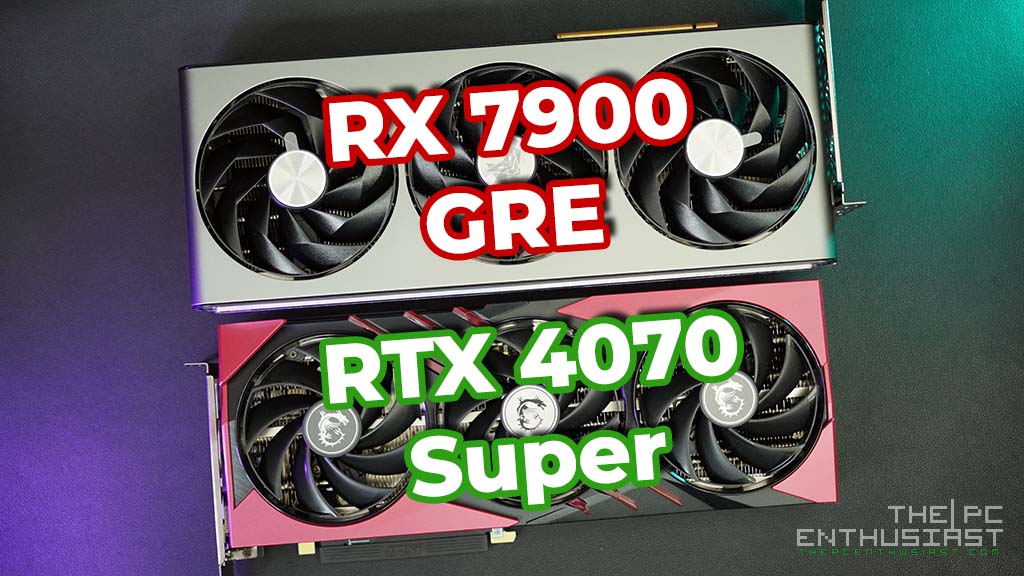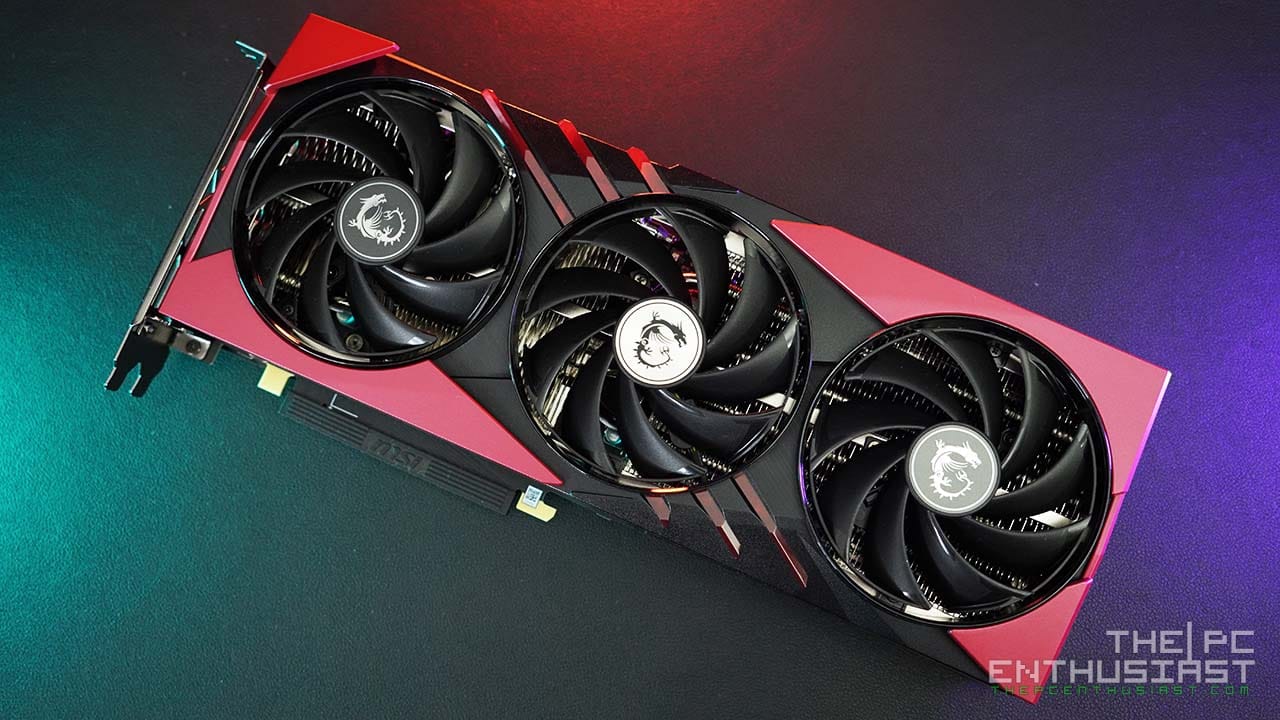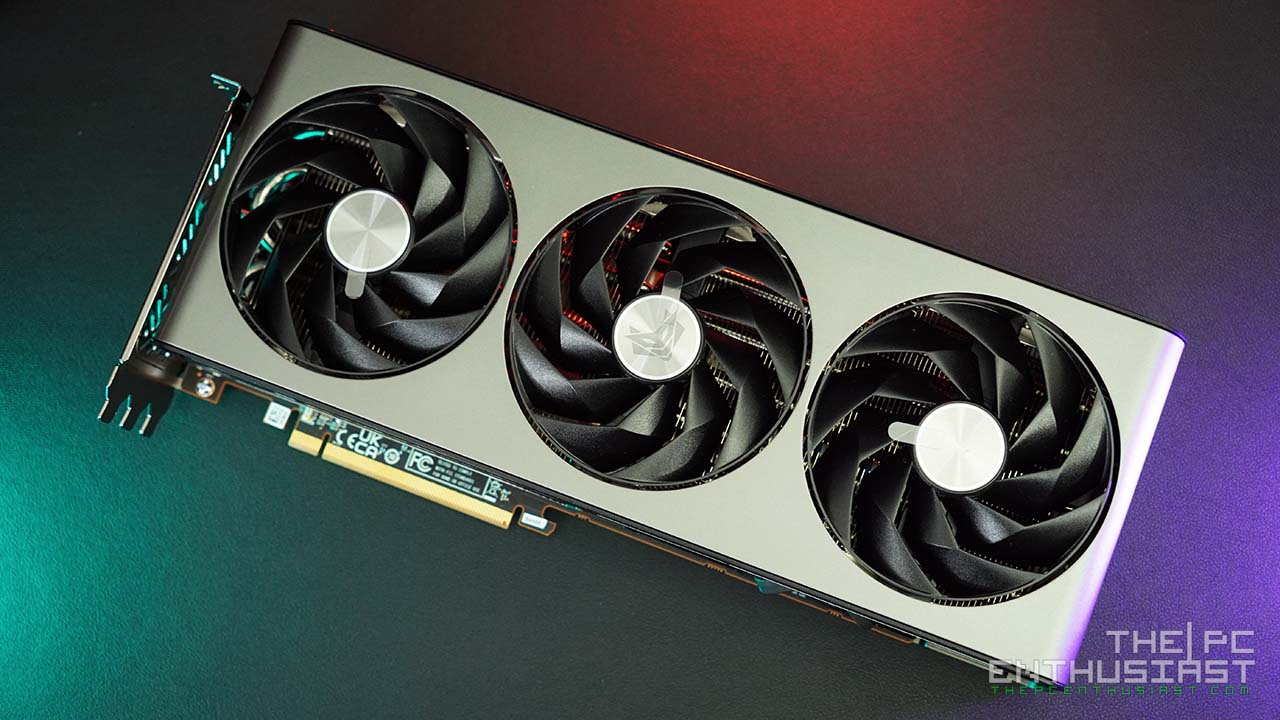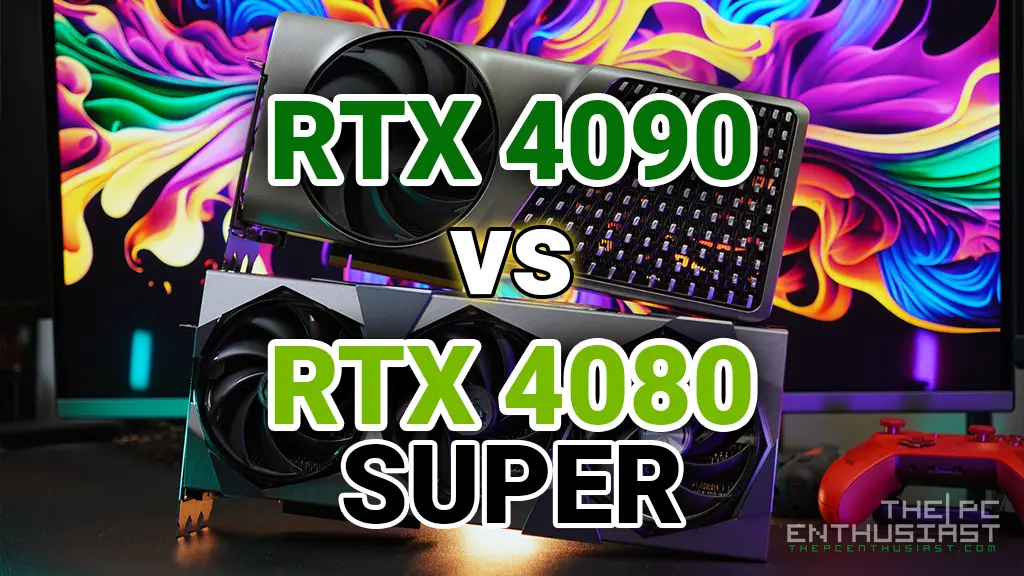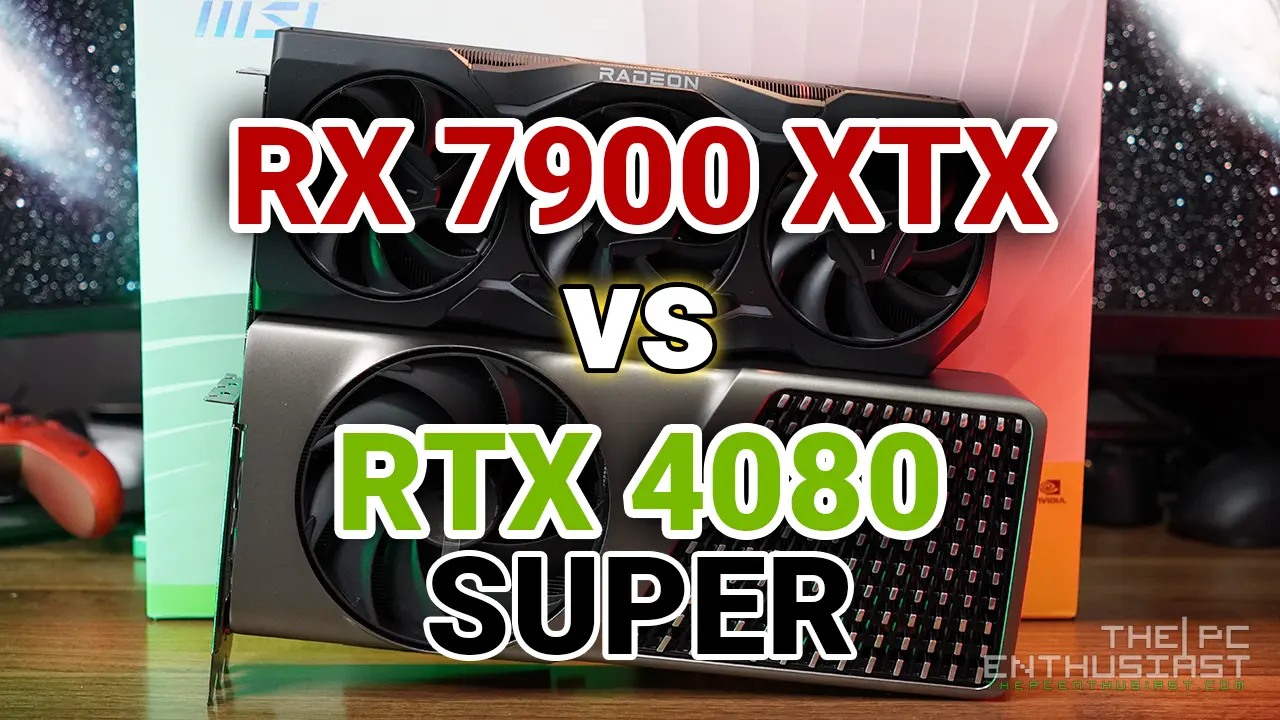The Radeon RX 7900 XT is one of AMD‘s latest graphics cards based on the new RDNA 3 architecture. It’s the “little brother” of the RX 7900 XTX that we previously reviewed. Since only a single letter, “X,” differentiates these two, you might think that’s not a lot of difference. Price-wise, that X is a one-hundred-dollar difference. The Radeon RX 7900 XTX has a launch price of $999, while the RX 7900 XT launched at $899. So, is the Radeon RX 7900 XT a better deal than the RX 7900 XTX? Is it also a better option than NVIDIA’s RTX 4070 Ti? Let’s find out in our review below.

AMD Radeon RX 7900 XT Graphics Card Review
Just a little rant before I start with the proper review. AMD’s current naming scheme is so confusing – RX 7900 XTX and RX 7900 XT. There’s only a single “X” that differentiates these two GPUs. It may not be confusing for the tech-savvy or a PC enthusiast who keeps track of these latest graphics cards. But for typical consumers, especially those unfamiliar with the naming scheme, this could be confusing and somewhat deceptive. They wouldn’t realize that the single letter (X) would mean an entirely different GPU. I wish AMD called it the “RX 7950 XT” instead, and I have no idea why they didn’t. Perhaps they have reserved that name, 7950, for a future GPU.

Moving on, AMD uses a chiplet design for their latest GPUs, combining 5nm and 6nm process nodes. Each node has its specific function, and by doing this, AMD was able to keep the GPU’s cost lower while offering better performance than its predecessor. With this method, the Radeon RX 7900 XT provides up to 1.5X higher performance than the Radeon RX 6900 XT GPU in select titles.
According to AMD, the breakthrough architecture delivers up to 54% more performance per watt than AMD RDNA 2 architecture. It features the world’s fastest interconnect linking the graphics and memory system chiplets at up to 5.3 TB/s. It also offers up to 96 new unified compute units, second-generation AMD Infinity Cache technology, and up to 24 GB of high-speed GDDR6 memory with up to a 384-bit memory interface. The new RDNA 3 architecture also includes increased AI throughput that delivers up to 2.7X higher AI performance and second-generation raytracing technology that provides up to 1.8X higher raytracing performance than AMD RDNA 2 architecture.
UPDATE: AMD’s Radeon RX 7900 GRE is now available in the US. Check out our Sapphire Nitro+ RX 7900 GRE review.


Below are the key features of the new Radeon RX 7900 Series GPUs.
Key Features
- AMD RDNA 3 Architecture – Featuring an advanced chiplet design, new compute units and second-generation AMD Infinity Cache technology, AMD RDNA 3 architecture delivers up to 54% more performance per watt than the previous-generation AMD RDNA 2 architecture. New compute units share resources between rendering, AI and raytracing to make the most effective use of each transistor for faster, more efficient performance than the previous generation.
- Chiplet Design – The world’s first gaming GPU with a chiplet design delivers up to 15% higher frequencies at up to 54% better power efficiency. It includes the new 5nm 306mm2 Graphics Compute Die (GCD) with up to 96 compute units that provide the core GPU functionality. It also includes six of the new 6nm Memory Cache Die (MCD) at 37.5mm2, each with up to 16MB of second-generation AMD Infinity Cache technology.
- Ultra-Fast Chiplet Interconnect – Unleashing the benefits of second-generation AMD Infinity Cache technology, the new chiplets leverage AMD Infinity Links and high-performance fanout packaging to deliver up to 5.3TB/s of bandwidth.
- Expanded Memory and Wider Memory Bus – To meet the growing requirements of today’s demanding titles, the new graphics cards feature up to 24GB of high-speed GDDR6 memory running at 20Gbps over a 384-bit memory bus.
- Dedicated AI Acceleration and Second-Generation Raytracing – New AI instructions and increased AI throughput deliver up to 2.7X more performance than the previous AMD RDNA 2 architecture, while second-generation raytracing technology delivers up to 1.8X more performance than the previous generation.
- DisplayPort™ 2.1 Support – The industry’s only high-end gaming graphics cards to support DisplayPort 2.1 technology with UHBR 13.5, offering up to 54Gbps of display link bandwidth and enabling high-refresh 4K (up to 480Hz) or 8K (up to 165Hz) gaming on next-gen displays.
- New AMD Radiance Display™ Engine – Provides 12 bit-per-channel color for up to 68 billion colors and higher refresh rate displays compared to AMD RDNA 2 architecture and includes support for DisplayPort 2.1 and HDMI 2.1a.
- High-Refresh Gaming – DisplayPort 2.1 provides increased display bandwidth compared to DisplayPort 1.4, with the ability to support up to 900Hz, 480Hz and 165Hz refresh rates for 1440p, 4K and 8K displays, respectively.
- Dual Media Engine – Supports simultaneous encode or decode streams up to 8K60 for HEVC and supports AV1 encode, delivering up to 1.8X higher engine frequency than AMD RDNA 2 architecture.
AMD Radeon RX 7900 GPU Specifications
| AMD Radeon RX 7900 XTX | AMD Radeon RX 7900 XT | AMD Radeon RX 6950 XT | AMD Radeon RX 6900 XT | |
|---|---|---|---|---|
| Manufacturing Process | GCD: TSMC 5nm MCD: TSMC 6nm | GCD: TSMC 5nm MCD: TSMC 6nm | TSMC 7nm | TSMC 7nm |
| Transistor Count | 58B | 58B | 26.8B | 26.8B |
| Architecture | RDNA3 | RDNA3 | RDNA2 | RDNA2 |
| GPU | Navi 31 | Navi 31 | Navi 21 | Navi 21 |
| Stream Processors | 6144 | 5376 | 5120 | 5120 |
| Compute Units | 96 | 84 | 80 | 80 |
| ROPs | 192 | 192 | 128 | 128 |
| Infinity Cache | 96MB | 80MB | 128MB | 128MB |
| Game Clock | 2300 MHz | 2000 MHz | 2100MHz | 2015MHz |
| Boost Clock | 2500 MHz | 2400 MHz | 2310MHz | 2250MHz |
| Memory Size Type | 24GB GDDR6 | 20GB GDDR6 | 16GB GDDR6 | 16GB GDDR6 |
| Memory Clock | 20 Gbps | 20 Gbps | 18 Gbps | 16 Gbps |
| Memory Bus Width | 384-bit | 320-bit | 256-bit | 256-bit |
| TDP | 355W | 300W | 335W | 300W |
| Release Date | December 13, 2022 | December 13, 2022 | May 10, 2022 | December 8, 2020 |
| Launch Price | $999 | $899 | $1,099 | $999 |
Check the latest pricing and availability: (#ad)
AMD Radeon RX 7900 XT graphics cards are available on Amazon.com here.
AMD Radeon RX 7900 XTX graphics cards are available on Amazon.com here.
Packaging and Closer Look

The vanilla Radeon RX 7900 XT has a similar box and art to the 7900 XTX’s packaging. However, unlike the 7900 XTX’s retail box, the 7900 XT doesn’t pop up when you open the box. Opening the lid will only reveal the 7900 XT, with no special pop-up effect. AMD may want to differentiate these graphics cards’ packaging or emphasize that the 7900 XTX is the better graphics.


The design of the Radeon RX 7900 XT reference model is mainly similar to the 7900 XTX as well. It has a nice all-black color scheme with a few highlights here and there. However, the RX 7900 XT has no (RGB) lighting on the front cooler shroud. With the RX 7900 XTX, you get a small RGB lighting on the middle portion of the front cooler shroud.
Of course, this is a reference model. RX 7900 series graphics cards from AIC partners will look totally different and will have RGB lighting. While I like the custom graphics cards from AMD’s partners, I also like how these reference model look. And frankly, I think AMD’s current generation reference cards look better than the previous generations.


The Radeon RX 7900 XT has the same output ports as the 7900 XTX. You get two DisplayPort 2.1, an HDMI 2.1a, and a USB Type-C port. At the rear end of the graphics card are mounting holes to secure the card on the chassis.


The Radeon RX 7900 XT also uses only two 8-pin PCIe power connectors. Note that some cards from AIC partners will require three 8-pin PCIe power connectors, like this MSI Radeon RX 7900 XT Gaming Trio Classic. However, having three 8-pin PCIe power connectors will not substantially increase the graphics card’s performance. There is no doubt that these custom cards will perform slightly better or faster, about 5% give or take, not to mention they run cooler as well. But at the end of the day, you should worry too much about the number of PCIe power connectors.
Radeon RX 7900 XT vs 7900 XTX Graphics Card Size
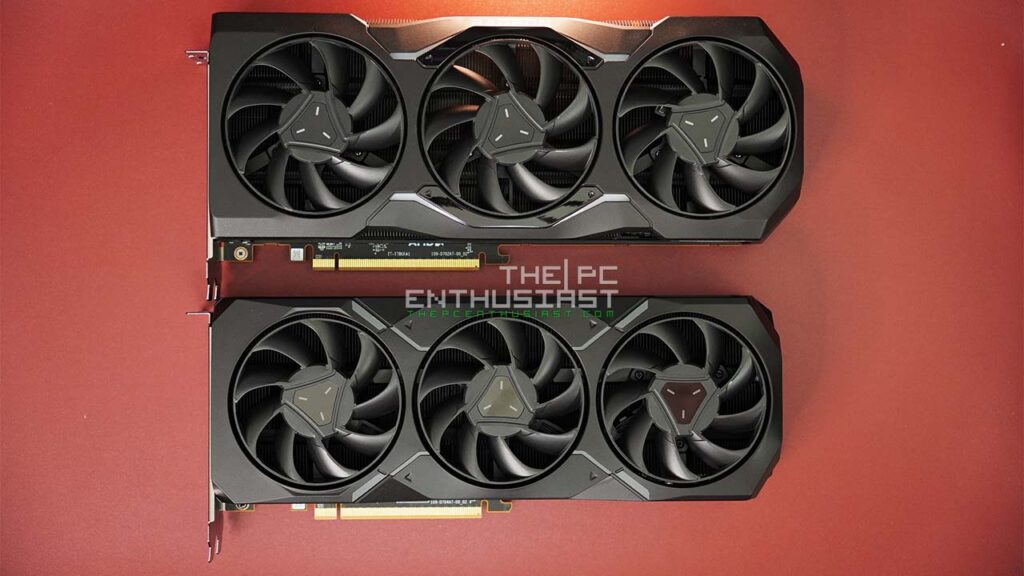


At first, I thought the RGB lighting was the only difference between the RX 7900 XT and RX 7900 XTX’s design. However, while swapping the cards on the test setup, I noticed that the RX 7900 XT is lighter. When I put them side by side, the RX 7900 XT is not only lighter, but it’s slightly smaller as well.
Of course, if you opt for a custom card, graphics cards from AIC partners will look the same, regardless if it’s the 7900 XT or XTX. They’ll use the same graphics card cooler to avoid unnecessary additional costs.
Radeon RX 7900 GPU Series Test Setup Review

I’m using an X670E motherboard with an AMD Ryzen 7 7700X to test the two Radeon RX 7900 series graphics cards. It is paired with a DDR5-5600MHz CL36 memory kit with the AMD EXPO profile enabled. Resizable BAR was also enabled from the BIOS settings. Below are the rest of the specifications of the system:
| Operating System | Windows 11 Pro |
| Processor | AMD Ryzen 7 7700X |
| Motherboard | MSI MPG X670E Carbon WiFi |
| Memory | Corsair Vengeance RGB DDR5-6000MHz CL30 AMD EXPO |
| Graphics Card | AMD Radeon RX 7900 XTX AMD Radeon RX 7900 XT |
| OS Drive | MSI Spatium M480 Play |
| Game Drive | SanDisk Extreme PRO Portable SSD V2 and Extreme Portable SSD V2 |
| Power Supply | MSI MPG A1000G PCIE5 |
| Chassis | MSI MPG Velox 100P Airflow |
| Monitor | MSI Optix MPG321UR-QD 4K 144Hz |
I used AMD’s Adrenalin 23.1.1 driver in testing the RX 7900 XT. It was tested in three resolutions – 1920×1080 FHD, 2560×1440 WQHD, and 3840×2160 4K UHD.
For synthetic benchmarks, I used 3DMark’s benchmark suite. I also used the following games to test the graphics card: Assassin’s Creed Valhalla, A Plague Tale: Requiem, Call of Duty Modern Warfare II, Deus Ex Mankind Divided, Horizon Zero Dawn, Monster Hunter World, Read Dead Redemption 2, Shadow of the Tomb Raider, The Division 2, and Watch Dogs Legion.
I also tested the RX 7900 XT with Cyberpunk 2077, Forza Horizon 5, and The Witcher 3 Next-Gen for the ray tracing-featured games.
Below is the GPU-Z screenshot of the Radeon RX 7900 XT.

AMD Radeon RX 7900 XT Benchmarks
Synthetic Benchmark Results







As you can see from the synthetic benchmark results above, there is a substantial difference between the RX 7900 XTX and 7900 XT. That’s why AMD should have named the 7900 XT or the 7900 XTX differently. A simple “X” at the end should not differentiate them. Instead, a different model number should be used.
We can also see that the RX 7900 XT is faster than its predecessor, the RX 6900 XT. The 7900 XT is also faster for most of the tests than the RTX 4070 Ti. However, during the Speed Way and Port Royal tests, we see that AMD still needs to catch up when ray tracing is enabled.
1080p Game Benchmark Results
I would not recommend getting any of these high-end graphics cards for 1080p gaming. The CPU/resolution could bottleneck these cards; they just don’t perform well in lower resolutions. The RX 7900 XT is more suited for 1440p gaming, although no one is stopping you from getting one if you have a 1080p monitor. Below are the results I got:









The Radeon RX 7900 XT generally performed faster than the RTX 4070 Ti and the RX 6900 XT. However, as I mentioned earlier, the lower resolution could potentially limit the GPU’s performance. We can see that on Deus Ex Mankind Divided and Watch Dogs legion where the RX 6900 XT outperformed the RX 7900 XT. This won’t happen if you are running the RX 7900 XT with a higher resolution monitor. Also, we can only see a small difference between the RX 7900 XT and RX 6900 XT on Shadow of the Tomb Raider and Horizon Zero Dawn.
1440p Game Benchmark Results
Going up to 1440p, the Radeon RX 7900 XT has more room to “stretch its legs” a bit. Below are the results that I got.
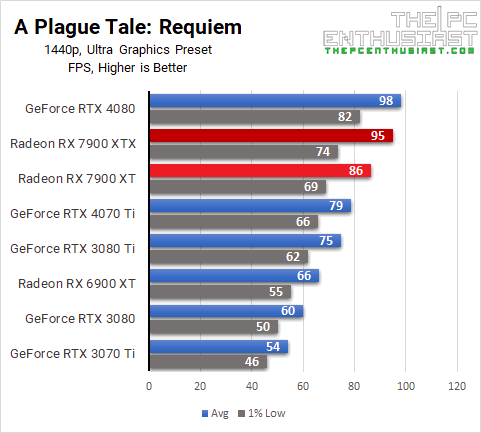








As you can see from the results above, the Radeon RX 7900 XT outperformed its predecessor, and this time in all game titles. It is the expected outcome. If you upgraded from an older generation, you should get better performance. If you upgraded to a newer and faster GPU, but got a similar or lower FPS instead, then there is something wrong with the setup.
The Radeon RX 7900 XT also performed (a bit) faster than the RTX 4070 Ti and was on par in some game titles. I expect that it would outperform the RTX 4070 Ti since it is a bit more expensive than NVIDIA’s GPU. It would be disappointing if it didn’t.
2160p Game Benchmark Results
Finally, at 4K, the GPUs will have all the room they need to push hard. At this resolution, it would be primarily GPU-bound, and only the fastest graphics cards in the market can drive games above 60 fps. See how the RX 7900 XT performs at 4K resolution below.
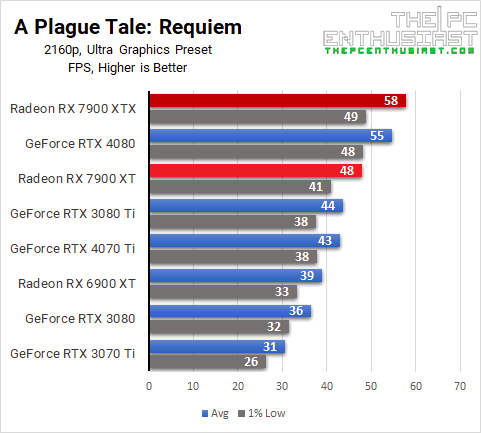








As you can see from the results above, the Radeon RX 7900 XT is sandwiched between the RTX 4080 and RTX 4070 Ti. When it comes to pricing, the 7900 XT also sits in between the two NVIDIA GPUs.
Although the RX 7900 XT is primarily not marketed as a 4K gaming GPU, we can see that it performed well at 4K. The 7900 XT can still push games above 60 fps, with max graphics settings, using traditional rasterization.
Speaking of traditional rasterization, let’s find out next how the RX 7900 XT performs when ray tracing is enabled and/or when upscaling technology is used.
Radeon RX 7900 XT Ray Tracing and FSR Benchmark Results
Call of Duty Modern Warfare II
Call of Duty Modern Warfare II doesn’t have ray tracing features, but it has FSR support. FSR is AMD’s answer to NVIDIA’s DLSS. On the left (top) are benchmark results without FSR, while on the right (bottom) are with FSR for AMD and DLSS for NVIDIA. The FSR and DLSS are set to quality settings.


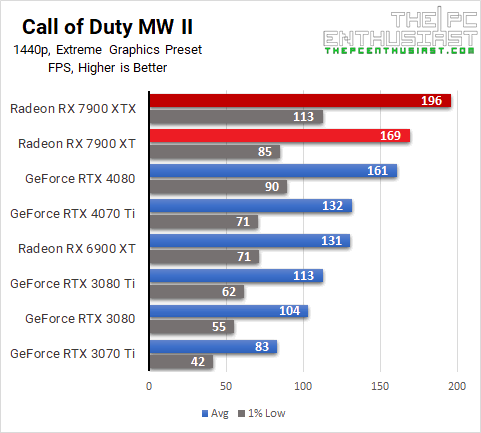

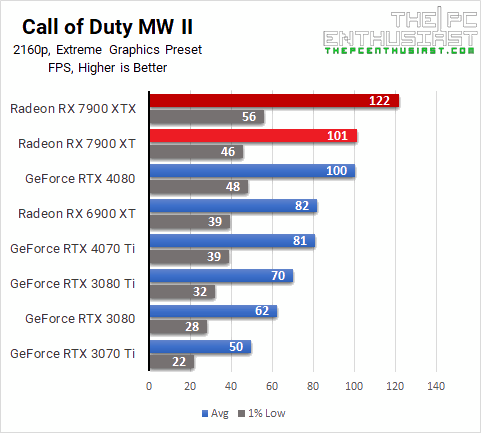

This game seems to favor AMD’s GPU. As you can see from the results, even the RX 7900 XT could outperform or at least perform on par with the RTX 4080. Up next is a game that leans towards NVIDIA’s GPUs.
Cyberpunk 2077
Cyberpunk 2077 is one very graphics-intensive game. And this game has been NVIDIA-leaning since its release. Below you can see the 1080p, 1440p, and 2160p results. In each resolution, you can see traditional rasterization, then with ray tracing only, and finally, ray tracing with upscaling technology enabled.
Here are the results for 1080p resolution:



Below are the results for 1440p resolution:
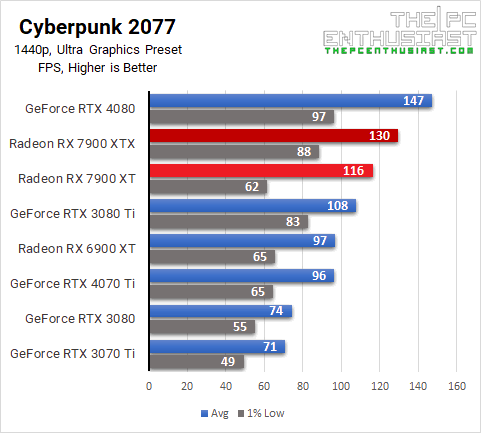


Finally, here are the results for 4K UHD resolution:
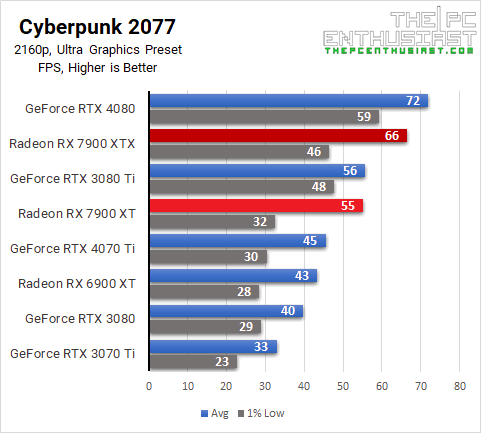


The Radeon RX 7900 XT didn’t perform well on this game title. Even AMD’s flagship 7900 XTX was struggling to get decent FPS. However, it doesn’t mean you can’t play and enjoy this game if you opt for an AMD GPU. With traditional rasterization, you can get decent frame rates using the RX 7900 XT. Enabling FSR will also help increase the frame rate. Although, if you want ray tracing enabled, you should lower the graphics settings or use a more aggressive FSR setting.
Forza Horizon 5
Forza Horizon 5 is another game that has ray tracing features. However, this game’s ray tracing is less intensive than Cyberpunk 2077. Below are the results:



As expected with any game with ray tracing enabled, AMD’s GPUs tend to trail behind. Nevertheless, even with ray tracing enabled, the RX 7900 XT can drive this game even at 4K resolution with decent frame rates.
The Witcher 3: Next-Gen
Finally, I tested the Radeon RX 7900 XT using the Witcher 3 Next Gen update. However, there is a performance issue with the new update. I tested this game before the 4.01 patch was rolled out. With the 4.01 update, I simply can’t finish or even start the game since it was crashing. The game developers already released a patch for 4.01, but I still need to test the new version. Anyway, before are the results I got.






I would not dive into details regarding the results that I got on Witcher 3 Next Gen. As I have said, the new update has some performance issues. And I am certain with the newly released patch, I’ll have to scratch these results and retest all the GPUs again. :/
Pricing and Availability
The Radeon RX 7900 XT is now available and has been in the market since December 2022. It is available in the reference model and custom design cards from AIC partners. The AMD Radeon RX 7900 XT has a SEP of $899 USD, while the flagship RX 7900 XTX has a SEP of $999 USD. AMD is known for adjusting its CPU and GPU prices a few months after the product has been released. So, kindly follow the links below for the latest pricing and availability.
AMD Radeon RX 7900 XT graphics cards are available on Amazon.com here.
AMD Radeon RX 7900 XTX graphics cards are available on Amazon.com here.
AMD Radeon RX 7900 XT Review Conclusion
With AMD’s latest Radeon RX 7900 series, I think the company did a great job. Overall, the performance of the RX 7900 XT is excellent for 1440p gaming. And it can also play games at 4K resolution on high or even maximum graphics settings. Of course, that depends on the game title. Games that are AMD sponsored or use an engine that favors AMD GPUs will perform better than their competition.
I like the reference design. It looks sleek with its all-black color scheme and red accent. However, I wish AMD didn’t remove the RGB lighting on the RX 7900 XT model. It could use a bit of a flare to it. Speaking of RGB lighting, if you want a more attractive-looking RX 7900 XT, check out the following graphics cards below.
- MSI Radeon RX 7900 XT Gaming Trio Classic
- Sapphire Nitro+ Radeon RX 7900 XT Vapor-X Gaming
- PowerColor Red Devil Radeon RX 7900 XT
- ASUS TUF Gaming Radeon RX 7900 XT
These cars are (a little bit) above the MSRP, but you are paying for a better cooling solution and aesthetics.
The reference design’s cooling performance isn’t bad, either. During my tests, the maximum GPU temperature I got was 73 °C. The highest clock speed it got is around 2940MHz, running at stock settings and with no overclocking involved.
A Few Concerns
The performance of the Radeon RX 7900 XT is quite good, especially in traditional rasterization. However, AMD needs to catch up when it comes to ray tracing and upscaling technology. Ray tracing and upscaling is the trend with new game titles. Games like Hogwarts Legacy, Forspoken, and upcoming titles like Black Myth: Wukong has and will have ray tracing and/or upscaling feature.
Also, I think if AMD dropped the RX 7900 XT’s price by about $100 less (at least), it would be more attractive to gamers than NVIDIA’s RTX 4070 Ti. While it is faster than the RTX 4070 Ti in traditional rasterization, the 7900 XT falls behind when ray tracing is involved. Not to mention, AMD’s competition has attractive features like DLSS 3 AI Frame Generation, dual AV1 NVENC, and other software-related feature.
Finally…
The AMD Radeon RX 7900 XT is an excellent graphics card for 1440p gaming. I’m not very excited about it since, for a “hundred dollars” more, the RX 7900 XTX is the better graphics card. I’m not sure why AMD released the 7900 XT together with the 7900 XTX, with only a $100 price difference and one letter less (X). But, it could use a $100-$200 discount to be more attractive.
Unless AMD discounts the RX 7900 XT by the time you read this review, the 7900 XTX is the more attractive GPU for me. But if AMD drops the price for its 7900 XT in the future and there’s a substantial price difference from the 7900 XTX, the Radeon RX 7900 XT could be the better choice.


